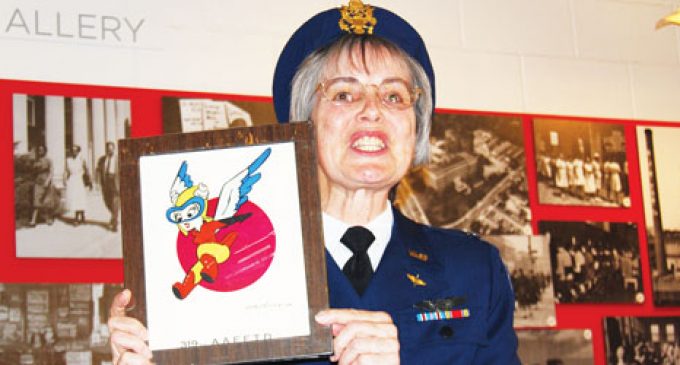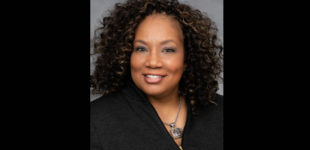Stories of trailblazing military women shared

(pictured above: Ann Zuhr talks about her mother, Margery Moore Holben.)
The New Winston Museum capped off Women’s History Month last Thursday by focusing on military trailblazers.
 The noontime program featured retired Capt. Linda Bray, who during the 1989 invasion of Panama became the first woman to lead U.S. troops in combat, and Ann Zuhr, who discussed her mother’s service in the Women’s Airforce Service Pilot (WASP) program during World War II.
The noontime program featured retired Capt. Linda Bray, who during the 1989 invasion of Panama became the first woman to lead U.S. troops in combat, and Ann Zuhr, who discussed her mother’s service in the Women’s Airforce Service Pilot (WASP) program during World War II.
Sanford native Bray was the commander of the 988th Military Police Company in Fort Benning, Ga. when the unit was sent on what at first was described as a “routine security deployment to Panama,” but when she arrived and was told that she should keep her head down, she knew she was being deployed into what would become a war zone.
“I never thought I’d be in that position in my life,” said Bray. “I thought I’d just skate through, just being a normal military person.”
Her unit, which relieved an 82nd Airborne unit, ended up in a firefight with Panamanian defense forces at a dog kennel that was used to conceal a cache of weapons. Her unit suppressed the enemy without casualties. When word got out that a woman had led the victorious unit, Bray found herself a sudden celebrity.
“The media went to my hometown; they went to my high school; they were talking to my high school friends,” said Bray, whose husband also served in the military. “They were trying to find out who my high school boyfriend was, what did I do in high school. Not only did they go to my high school, they went to my parent’s house, my husband’s house or our house. It was like my whole life just got put out there on paper. There was nothing private about me anymore.”
The notoriety also sparked controversy, as the public and members of Congress debated about whether or not women belonged in combat. She compared the scrutiny to being in a tornado.
“I went through a category five media frenzy,” she said. “Your entire life is disrupted. I was sent letter bombs. I was sent unmentionable things.”
She said all the attention and controversy prompted her to request a discharge from the Army in 1991. She looks back on her service fondly and is pleased that she helped pave the way for gender equality in the military. Last year, the ban on women in combat was lifted.
“Whether you were civilian or military, (there are) gaps between the men and the female; hopefully we’re heading in the right direction,” she said.
Zuhr told the story of her mother, Margery Moore Holben, and other pilots in the WWII WASP program, as she wore a version of Holben’s uniform.
The idea of women military pilots started with a letter between a famous aviator and the first lady.
“Jaqueline Cochran, a pilot since the early 1930s and an air race competitor wrote to Eleanor Roosevelt in September 1940 about forming a women’s auxiliary to the Army Air Force,” said Zuhr, describing the genesis of the WASP. “Her idea was that women could do domestic non-combat aviation and thus release male pilots for combat duty.”
In 1942, the Women’s Auxiliary Ferrying Squadron was organized, allowing highly-qualified pilots to deliver newly-built planes from the factory to military bases. Also in 1942, training began for the Women’s Flying Training Detachment under Cochran, whose duties included everything from delivering repaired planes to bases to performing flight checks. The two programs were merged into WASP in 1943. During its 16-month existence, 25,000 women applied for WASP training. Only 1,879 were accepted and 1,074 completed the program – better than the 50 percent “washout” rate of male pilot cadets.
Holben piloted a plane that towed moving targets to allow artillery gunners to practice shooting down aircraft. Zuhr said aside from the obvious danger of the guns hitting the plane, mechanical failure could also prove fatal. During one run, her mother’s hydraulics went out, causing the plane’s bomb bay doors and landing gear to open. If she had not landed the plane flawlessly, the bomb bay door would have dug into the ground and destroyed the plane. Holden landed without so much as a scratch.
As the war flagged, the need for pilots diminished. In 1944, the WASPs were disbanded without the women being recognized as having served in the military.
“It was very hurtful for these women who were serving their country to be told, ‘You’re no longer needed; go home,’ even though the war was not yet over,” said Zuhr. “Their service was not recognized for another 33 years.”
Holden was still alive in 1977, when the WASPs and other women were finally recognized as military veterans, but it wasn’t until 13 years after her death in 2000 that WASPs received the Congressional Gold Medal.
The New Winston Museum, which uses photos, videos and guest speakers to tell the story of Winston-Salem from 1849 – when Forsyth County was incorporated – until today, was an appropriate place for the women’s stories to be shared, according to Museum Executive Director Katherine Foster.
“We collect stories, and our speakers today are going to help build … that,” she said.














